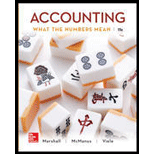
Concept explainers
Concept Introduction:
Direct Labor - Direct labor is the labor cost of the employees who convert materials into finished products.
Direct labor efficiency variance-
Direct labor efficiency variance is the variance which measures the difference between standard hours allowed and actual hours taken for the work done. If actual hours are more than the standard hours allowed then the variance is unfavorable and if actual hours are less than the standard hours allowed then the variance is favorable.
Direct labor rate variance-
Direct labor rate variance is the variance which measures the difference between standard rate and actual hourly rate paid.. If actual rate paid is more than the standard rate then the variance is unfavorable and if actual rate paid is less than the standard rate then the variance is favorable.
Requirement 1-
To complete:
Performance report.
Answer to Problem 15.10E
| Flexible Budget | Actual | ||
| Direct labor | $1,380 | $1,573 | $193 U |
Explanation of Solution
Given,
- Actual production of stamping = 230,000
- Standard stampings per hour = 2,000
- Standard rate per hour = $12
- Actual direct labor cost = $1,573 First we need to find standard hours for actual production-
Budget variance is calculated as follows-
Conclusion:
Thus, performance report is computed.
Concept Introduction:
Direct Labor - Direct labor is the labor cost of the employees who convert materials into finished products.
Direct labor efficiency variance-
Direct labor efficiency variance is the variance which measures the difference between standard hours allowed and actual hours taken for the work done. If actual hours are more than the standard hours allowed then the variance is unfavorable and if actual hours are less than the standard hours allowed then the variance is favorable.
Direct labor rate variance-
Direct labor rate variance is the variance which measures the difference between standard rate and actual hourly rate paid.. If actual rate paid is more than the standard rate then the variance is unfavorable and if actual rate paid is less than the standard rate then the variance is favorable.
Requirement 2-
To calculate:
Direct labor efficiency variance and direct labor rate variance.
Answer to Problem 15.10E
Explanation of Solution
Direct labor efficiency variance-
Given,
- Standard rate = $12
- Actual hours worked = 121 hours
Direct labor efficiency variance is calculated as follows-
Direct labor rate variance-
Given,
- Standard rate = $12
- Actual hours worked = 121 hours
- Actual labor cost = $1,573
Direct labor rate variance is calculated as follows-
Conclusion:
Under direct labor efficiency variance, since standard hours are less than the actual works worked, hence variance is unfavorable.
Under direct labor rate variance, since standard rate is less than the actual rate, hence variance is unfavorable.
Concept Introduction:
Direct Labor - Direct labor is the labor cost of the employees who convert materials into finished products.
Direct labor efficiency variance-
Direct labor efficiency variance is the variance which measures the difference between standard hours allowed and actual hours taken for the work done. If actual hours are more than the standard hours allowed then the variance is unfavorable and if actual hours are less than the standard hours allowed then the variance is favorable.
Direct labor rate variance-
Direct labor rate variance is the variance which measures the difference between standard rate and actual hourly rate paid.. If actual rate paid is more than the standard rate then the variance is unfavorable and if actual rate paid is less than the standard rate then the variance is favorable.
Requirement 3-
To determine which alternative would improve control over stamping department's direct labor.
Answer to Problem 15.10E
Including the direct labor rate variance and direct labor efficiency variance separately in the monthly report would improve the control over stamping department's direct labor. The variance needs to be clearly classified into rate and efficiency variance so that department personnel understand it in better way.
Explanation of Solution
Answer explained above.
Conclusion:
Thus, answer is explained.
Want to see more full solutions like this?
Chapter 15 Solutions
Accounting: What the Numbers Mean

 AccountingAccountingISBN:9781337272094Author:WARREN, Carl S., Reeve, James M., Duchac, Jonathan E.Publisher:Cengage Learning,
AccountingAccountingISBN:9781337272094Author:WARREN, Carl S., Reeve, James M., Duchac, Jonathan E.Publisher:Cengage Learning, Accounting Information SystemsAccountingISBN:9781337619202Author:Hall, James A.Publisher:Cengage Learning,
Accounting Information SystemsAccountingISBN:9781337619202Author:Hall, James A.Publisher:Cengage Learning, Horngren's Cost Accounting: A Managerial Emphasis...AccountingISBN:9780134475585Author:Srikant M. Datar, Madhav V. RajanPublisher:PEARSON
Horngren's Cost Accounting: A Managerial Emphasis...AccountingISBN:9780134475585Author:Srikant M. Datar, Madhav V. RajanPublisher:PEARSON Intermediate AccountingAccountingISBN:9781259722660Author:J. David Spiceland, Mark W. Nelson, Wayne M ThomasPublisher:McGraw-Hill Education
Intermediate AccountingAccountingISBN:9781259722660Author:J. David Spiceland, Mark W. Nelson, Wayne M ThomasPublisher:McGraw-Hill Education Financial and Managerial AccountingAccountingISBN:9781259726705Author:John J Wild, Ken W. Shaw, Barbara Chiappetta Fundamental Accounting PrinciplesPublisher:McGraw-Hill Education
Financial and Managerial AccountingAccountingISBN:9781259726705Author:John J Wild, Ken W. Shaw, Barbara Chiappetta Fundamental Accounting PrinciplesPublisher:McGraw-Hill Education





